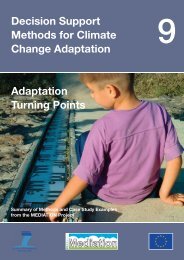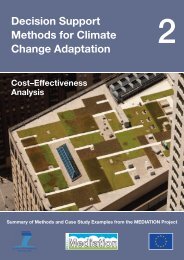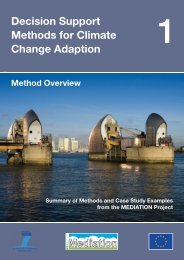Download all Technical Policy Briefing Notes in a single ... - Mediation
Download all Technical Policy Briefing Notes in a single ... - Mediation
Download all Technical Policy Briefing Notes in a single ... - Mediation
- No tags were found...
Create successful ePaper yourself
Turn your PDF publications into a flip-book with our unique Google optimized e-Paper software.
DecisionSupport 8There are many ways to apply SNA to aparticular context. The ma<strong>in</strong> steps <strong>in</strong> quantitativeand qualitative SNA are outl<strong>in</strong>ed below.Quantitative Social Network AnalysisQuantitative SNA aims at captur<strong>in</strong>g the entirerelevant network. The steps for quantitativesocial network analysis are:• Clarify<strong>in</strong>g objectives and def<strong>in</strong><strong>in</strong>g the scope ofanalysis (e.g. mapp<strong>in</strong>g a knowledge doma<strong>in</strong>).• Develop<strong>in</strong>g a survey methodology anddesign<strong>in</strong>g the questionnaire.• Identify<strong>in</strong>g the participants (network) andprovid<strong>in</strong>g justification for boundaries (ifappropriate).• Collect<strong>in</strong>g survey data and gather<strong>in</strong>g further<strong>in</strong>formation from other resources.• Analys<strong>in</strong>g the data through formal methods.• Review<strong>in</strong>g process and outcomes to identifyproblems/opportunities.• Design<strong>in</strong>g and implement<strong>in</strong>g actions to br<strong>in</strong>gabout desired changes.• Mapp<strong>in</strong>g the network aga<strong>in</strong> after anappropriate period of time.This is a resource <strong>in</strong>tensive task, and fieldresearch requires very high response rates, andhigh resources, as any miss<strong>in</strong>g data can weakenthe analysis. Other approaches us<strong>in</strong>g exist<strong>in</strong>gdata (e.g. co-citation networks, onl<strong>in</strong>edatabases, household surveys) can also beconsidered, though it is not always easy toextract relational <strong>in</strong>formation or perform suitabledata transformations.Qualitative Social Network AnalysisQualitative social network analysis or socialnetwork mapp<strong>in</strong>g (SNM) takes advantage of theearly steps above – the <strong>in</strong>terviews, surveys orfocus group discussions – to elicit <strong>in</strong>formation onthe relevant networks. It can facilitate richdiscussions, shared understand<strong>in</strong>g and<strong>in</strong>creased awareness between differentstakeholders. This can be part of a rapidappraisal before detailed analysis beg<strong>in</strong>s. It canalso identify entry po<strong>in</strong>ts for policy <strong>in</strong>fluence(Turnpenny et al., 2005) and other ‘flows’ ofresources which can <strong>in</strong>clude ‘<strong>in</strong>formal capital’.A number of approaches and tools can be usedfor network analysis. Follow<strong>in</strong>g Schiffer (2010),the NetMap guidance is a useful example forapply<strong>in</strong>g the approach <strong>in</strong> a participatory way. Themethod is usu<strong>all</strong>y applied us<strong>in</strong>g flipcharts, post-itnotes and flat counters with a group ofstakeholders who are split <strong>in</strong>to homogeneousgroups related to the type of <strong>in</strong>stitution theybelong to e.g. Government level representatives,NGOs, farmers, etc.Once the adaptation research question is welldef<strong>in</strong>ed, participants go through the mapp<strong>in</strong>gexercise <strong>in</strong>clud<strong>in</strong>g an analysis of the network,and then come back <strong>in</strong>to plenary for a discussionof the different networks from the differentstakeholder perspectives. This enables a better‘shared understand<strong>in</strong>g’ of differ<strong>in</strong>g world views.A range of software exists for both quantitativeand qualitative SNA. This <strong>in</strong>cludes software forvisualisation and analysis, such as GEPHI,UCINET, ORA and NetDraw.The Application to AdaptationThe IPCC special report on extreme events(IPCC, 2012) confirms the viewpo<strong>in</strong>t ofadaptation as a socio-<strong>in</strong>stitutional process,def<strong>in</strong><strong>in</strong>g adaptation as a process of adjustmentto the actual or expected climate and its effects,<strong>in</strong> order to moderate harm or exploit beneficialopportunities.There is now an <strong>in</strong>creas<strong>in</strong>g body of research onthe role of socio-<strong>in</strong>stitutional networks <strong>in</strong> climateadaptation as there is for natural resourcemanagement (Bod<strong>in</strong> and Crona, 2009, Ste<strong>in</strong> etal., 2011). Down<strong>in</strong>g (2012) contrasts a predictand-provideviewpo<strong>in</strong>t with a process-basedunderstand<strong>in</strong>g of adaptation. Berkhout et al.,(2006) found that many of the resources requiredfor carry<strong>in</strong>g out the process of adaptation lieoutside the boundary of a particular organization.As a result, <strong>in</strong>ter-relationships betweenorganisations are <strong>in</strong>fluential <strong>in</strong> determ<strong>in</strong><strong>in</strong>g how(and if) adaptation processes will occur.Follow<strong>in</strong>g from this, it is important to identify theexist<strong>in</strong>g socio-<strong>in</strong>stitutional landscape andfeedback processes <strong>in</strong> climate adaptationresearch, to speed up the necessary ‘climateadaptedrout<strong>in</strong>es and capability to be developed’(Berkhout et al., 2006). This process-basedunderstand<strong>in</strong>g requires a ‘mapp<strong>in</strong>g’ of theproblem fram<strong>in</strong>g and actors. SNA has the4





